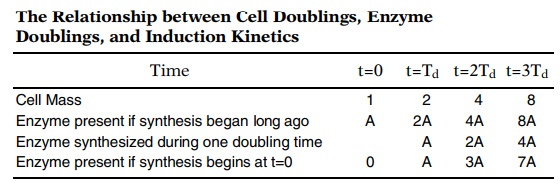Chapter: Genetics and Molecular Biology: An Overview of Cell Structure and Function
Composition Change in Growing Cells
Composition Change in Growing Cells
In many experiments it is necessary to consider the time course of the induction of an enzyme or other cellular component in a population of growing cells. To visualize this, suppose that synthesis of an enzyme is initiated at some time in all the cells in the population and thereafter the synthesis rate per cell remains constant. What will the enzyme level per cell be at later times?
The Relationship between Cell Doublings, Enzyme Doublings, and Induction Kinetics

One way to handle this problem is to consider a closely related problem we can readily solve. Suppose that synthesis of the enzyme had begun many generations earlier and thereafter the synthesis rate per cell had remained constant. Since the synthesis of the enzyme had been initiated many cell doublings earlier, by the time of our consideration, the cells are in a steady state and the relative enzyme level per cell remains constant. As the cell mass doubles from 1 to 2 to 4, and so on, the amount of the enzyme, A, also doubles, from A to 2A to 4A, and so on. The differences in the amount of the enzyme at the different times give the amounts that were synthesized in each doubling time. Now consider the situation if the same number of cells begins with no enzyme but instead begins synthesis at the same rate per cell as the population that had been induced at a much earlier time (see the last row in the table). At the beginning, no enzyme is present, but during the first doubling time, an amount A of the enzyme can be synthesized by the cells. In the next doubling time, the table shows that the cells can synthesize an amount 2A of the enzyme, so that after two doubling times the total amount of enzyme present is 3A. After another doubling time the amount of enzyme present is 7A. Thus at successive doublings after induction the enzyme level is 1Ōüä2, 3Ōüä4, 7Ōüä8,... of the final asymptotic value.
Related Topics